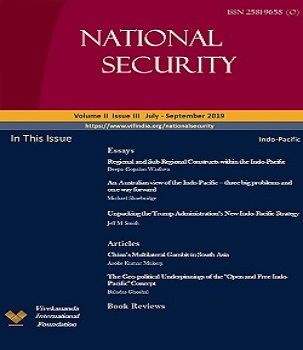About the Issue
The Indo-Pacific concept has emerged as the most useful for grasping the maritime and strategic trends in the vast but increasingly integrated region stretching from the Gulf and East Africa to India and East Asia and then to the United States. As against the much-used term Asia-Pacific with its focus on the international politics of the Western Pacific and North Asia, or the Indian Ocean Rim that excludes the major powers of the East, the Indo-Pacific concept emphasizes the crucial role of India in the strategic system of the region, as well as the vital role of the United States, Japan, China, Australia, the ASEAN and Gulf states, and their interdependence and emerging rivalries. From the perspective of flows of goods and services across and between the Indian and Pacific oceans– most importantly energy flows from the West to South and East Asia, too, the Indo Pacific makes abundant sense. It is here also that the rise of China and India is altering the strategic landscape and power balances. As China’s rise and its assertive and expansionist posture unravels the established order, a new balance of power and institutional structure that can preserve peace will be needed.
It is to comprehend the diverse perspectives, interests and strategies shaping the region, that we devote this special issue of the National Security to the Indo-Pacific. Centrally situated between the more volatile and conflicted western zone and an assertive China in the east that swears by the utility of power, India has an abiding interest in the stability, peace and sustenance of a law based open and inclusive order. The issue is dedicated towards grasping the broad trends underway so that policy options for realizing that goal become clearer.
Letters and Comments
Readers can share their views on National Security by e-mail to: the Editor, National Security. E-mail: nationalsecurity@vifindia.org
For more information go through submission guidelines
Editor's Note
Editorial Board
International Editorial Advisory Board
Contents : Vol. II Issue III | July - September 2019
Essays
Regional and Sub-Regional Constructs within the Indo-Pacific | Deepa Gopalan Wadhwa
An Australian view of the Indo Pacific – three big problems and one way forward | Michael Shoebridge
Unpacking the Trump Administration’s New Indo-Pacific Strategy | Jeff M Smith
Articles
China’s Multilateral Gambit in South Asia | Asoke Kumar Mukerji
The Geo-political Underpinnings of the "Open and Free Indo-Pacific" Concept | Baladas Ghoshal
Importance of East Africa in Indo-Pacific | Neha Sinha
Geopolitics of the South Pacific and Opportunities for India | Maitrayee Shilpa Kishore
Book Reviews
The Indo-Pacific in India’s imagination | Amruta Karambelkar
India and Asia’s Changing Balance of Power | Manish
Indo-Pacific – Diverse Perspectives | Udayan Das
Important Information
- The copyright of National Security rests with VIF.
- Submissions to National Security should be original and not published elsewhere or submitted for publication elsewhere. The Publication reserves the first right of refusal.
- The submissions will be peer reviewed/refereed as well as undergo a plagiarism check.
- The Editor/Institute reserves the right to make a final decision on the publication, National Security post-review as well as the right to make alterations.
Selected contributors will be informed of the decision to include their articles in the forthcoming Publication via email. - If the author seeks to use an article published in National Security as part of another work, then you will need to get the requisite permission from the Publication, National Security.
All Rights Reserved.
No part of this publication may be reproduced, stored in a retrieval system, or transmitted in any form, or by any means- electronic, mechanical, photocopying, recording or otherwise- without the prior permission of VIF.


Post new comment